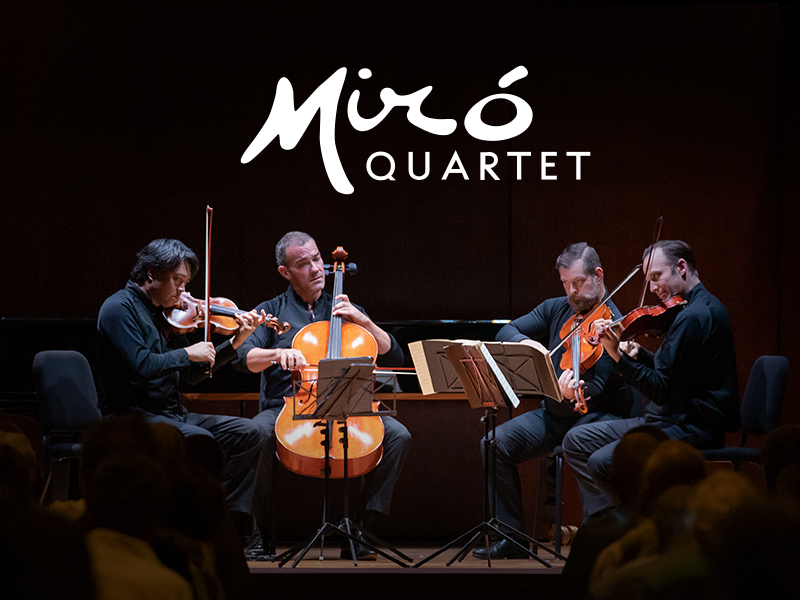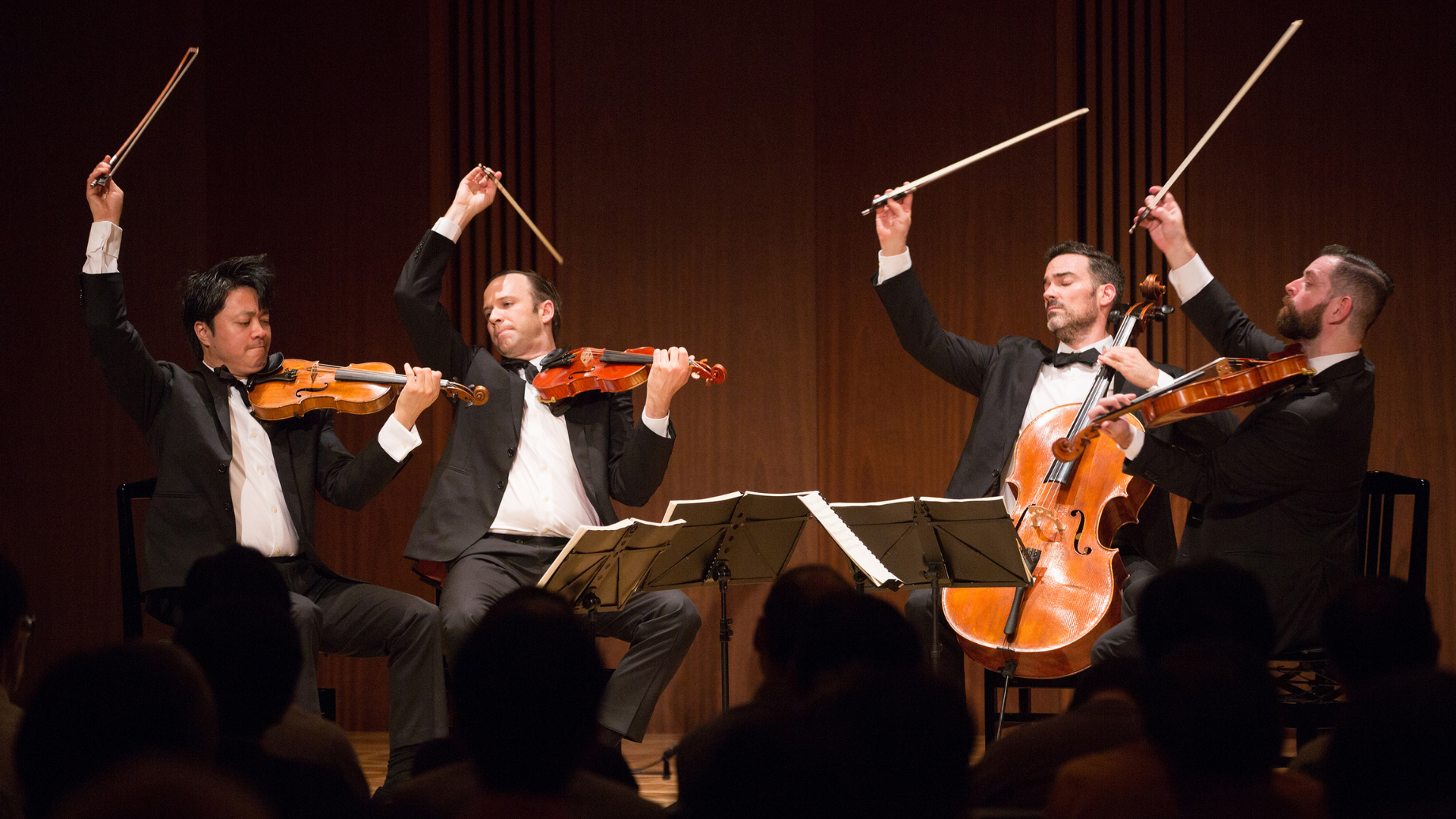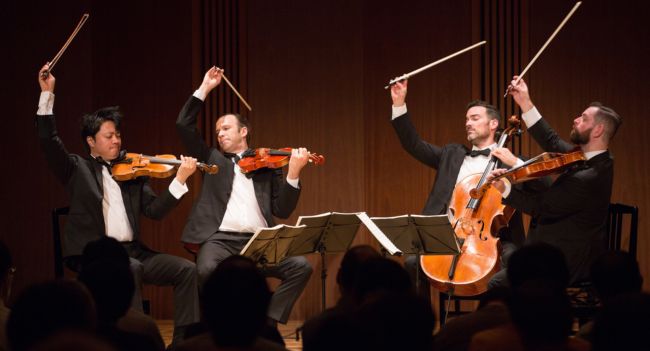When the Miró Quartet started out in October 1995, a prediction that it would be thriving a quarter century on must have sounded wildly optimistic. “Because we were such different personalities in terms of musical approach and demeanor, we had a lot of fights and disagreements in the first couple of years,” recalls cellist Joshua Gindele, who, together with first violinist Daniel Ching, founded the ensemble as a student projectat Oberlin Conservatory. “We spent a lot of time talking and actually had trouble finding time to play.”
Gindele suggested their name after being impressed by a quote from the Spanish Surrealist painter and sculptor Joan Miró: “The works must be conceived with fire in the soul but executed with clinical coolness.” Back then, the Mirós were champing at the bit to emulate the discipline and achievements of such “elders” as the Juilliard and Cleveland quartets. Little did they foresee that they would themselves become admired mentors—a trusted source of wisdom and advice for a new generation of chamber musicians just as eager and ambitious as they had been in those early, hungry years.

The Miró Quartet is celebrating its 25th anniversary season with two major undertakings. The first neatly converges with the music world’s Beethoven-at-250 tributes—and at the same time underscores the Miró’s own artistic evolution. Since its debut release in 2005, an account of Beethoven’s Op. 18 quartets, the ensemble has gradually worked its way through the composer’s complete quartet cycle. Its most recent additions came in 2018, and on November 15, Pentatone will issue a comprehensive box set that includes three quartets the ensemble is releasing for the first time (Ops. 127, 132, and 135).
The ensemble’s second initiative, the Miró Quartet Archive Project, is an ambitious ode to the American performance history of the string quartet itself as a medium. It involves recreations of historical programs played by three legendary quartets during the first half of the 20th century.
Secret of Longevity

So how did the Mirós arrive at this milestone? Violist John Largess gave up his job as principal violist with the Charleston Symphony—his second out of music school—when he was invited to join the ensemble in 1997 (replacing Cathy Basrak, who took on the position of assistant principal violist of the Boston Symphony Orchestra). He remembers that at the 1998 Aspen Festival, “we were constantly having arguments. A lot of our mentors talked about what being malleable in a quartet means. You need to be curious about what your colleagues are doing, but you also have to be true to yourself as an individual.”
They took a kind of homeopathic approach. “We learned that if we do really want to get along, we have to practice not getting along. And then we developed a lot of tools to get along,” Largess says. They also learned from one group of mentors—the Juilliard Quartet, with whom they did a residency at the end of the Robert Mann era—to dial down the pressure by questioning whether “there really is ‘a right way’ to play a piece. We got good at doing different peoples’ ideas and discovering new ways over different performances. You just had to be super-passionate about playing it.”
“We decided to pay attention to what was keeping us from playing. And we discovered that being flexible around everyone’s needs personally and musically was the key to longevity and success,” explains Gindele. “To this day, we are more focused on peoples’ happiness and allowing time for family, children, personal well-being. If that means we have to play a little less repertory or take a little more time off than other quartets choose to, we do that.”
Their method has resulted in a remarkable degree of stability, with just three changes of personnel since the Mirós started out. Early on, Sandy Yamamoto replaced Jennifer Choi as second violinist, and after Largess came onboard in 1997, the lineup remained unchanged until Yamamoto—who is married to Daniel Ching—decided to retire from the ensemble in 2011 to focus on raising the couple’s children. William Fedkenheuer was chosen to take her place following a rigorous, nine-month search.
Such consistency, Gindele asserts, results from “the culture we have cultivated in the group. Our guiding principle is that if we are passionate about something and love it, we will do it.”

But the initial imperative was to establish their credentials. For their first five years or so, the Mirós focused on mastering the repertoire dictated by the competition circuit. Those efforts earned them one resounding success after another: first prizes at Banff (1998) and Naumburg (2000) and an Avery Fisher Career Grant in 2005 (the first chamber-music ensemble to be so awarded).
In 2003, on an invitation from former Eastman dean Robert Freeman, the Miró Quartet inaugurated its ongoing tenure as faculty string quartet-in-residence at the Sarah and Ernest Butler School of Music at the University of Texas at Austin. “We’ve found Austin an incredible place to live. The institution has been incredibly supportive,” Gindele says. “It allows us to enjoy our family lives and teach. And the pace is a little slower than it is on either of the coasts”—which makes for a good grounding after touring.
The fact that the Mirós still exude a remarkably youthful aura is likely attributable at least in part to their regular interaction with students. “We’re doing this because we love it,” says Gindele. “We want to bring all our voices and curiosity to these pieces. You can be assured that if you hear us play a piece twice, it won’t be the same. Our relationship to art and to each other is shifting and alive.”
Synchronicity of Anniversaries: Beethoven’s Quartets

The Mirós’ interaction with Beethoven offers an ideal frame in which to observe this aesthetic of malleability in action. Early in their career, the ensemble decided to record all of Beethoven’s quartets at roughly the same age as the composer when he wrote them. The Op. 18 quartets (with Sandy Yamamoto on second violin—William Fedkenheuer plays on all of the other quartets) served as the vehicle for their debut release in 2005, after which the musicians waited until 2012 to record the middle-period Razumovsky Quartets, Op. 59.
If you look back at Rob Cowan’s Gramophone review of their first release (the Op. 18 quartets), he discerningly predicted this process of unfolding: “Whichever way you react to this or that passing detail, one thing’s for sure: They never sound studio-bound or stilted. The Mirós’ approach to these epoch-making masterpieces is consistently animated and imaginative, often keenly driven though, nearly always dispatched with a light touch . . .[T]heir playing suggests huge potential. All that’s needed is a little time to settle.”
Since the middle quartets, the Mirós have allowed for some time compression and followed a pattern of interspersing the later Beethoven quartets with recordings of Schubert. Still, the entire odyssey has ended up spanning 14 years up through the release of the completed set this November. In more recent years, the ensemble has recorded in Bastyr University Chapel—just north of Seattle, a space with acoustics that have become popular for film soundtracks. The earlier recordings have been remastered for the Pentatone box set.
The greatest benefit of this prolonged process, according to Gindele, is that it feeds off the musicians’ persistent curiosity. “Every time we come back to a piece, we devote a lot of time to re-exploring it. We give ourselves time to relearn quartets, like Op. 127 and 132, that we’ve played in live performance. Time and experience bring different perspectives. Not necessarily better, but it allows us to discover new things in the quartets and to approach them with flexibility.”
When performing the complete cycle—as they are doing over the course of this season in Portland, Seattle, and elsewhere—the Mirós also prefer the chronological approach (which takes into account the order of their composition, not publication number).
Largess points out that this has the advantage of emphasizing the role of the quartets in Beethoven’s personal life. “So much about the quartets is personal and contains these authentic emotions. It might not be narrative, but it is so personal in the way it relates to different times of his life. So you find him trying to show off his charming, virtuosic wit at the Op. 18 age, when he was not at all the person he was in the late quartets, frustrated with his relationships. Beethoven was sick a lot in the two years at the end of his life. He didn’t necessarily know death was looming, but there’s a lot more awareness of the mystical, transcendent, and sorrowful in these late pieces.”
The Miró Quartet Archive Project
The prospect of reaching the quarter-century milestone inspired the Mirós to reflect on how they got started and became such a success. That meant thinking of “our debts of gratitude,” Gindele says, “and of the lineage of mentorship for classical music in America—especially for the touring string quartet—stretching back two generations ago, to around the turn of the century, when our teachers’ teachers were pursuing their careers.”
The musicians developed the Miró Quartet Archive Project as a way to celebrate not just their own past but their sense of connectedness to formative mentors and to the rich history of the string-quartet medium itself. “Live chamber music is a tradition that has passed from one generation to another,” observes Largess. He mentions the pivotal roles played by the Juilliard and Cleveland quartets, as well as invaluable lessons learned from the Emersons, Orions, Leon Fleisher, and Isaac Stern. “You can’t really learn it from reading a book or watching a video or listening to a recording. We want to pay tribute to this concept of mentorship and the unbroken tradition.”
In his case, during his youth in Boston, Largess had the opportunity to study with Eugene Lehner, one of the violists of the Kolisch Quartet, who created the viola part of Bartók’s String Quartet No. 5 for its world premiere at the Library of Congress in April 1935. That historic performance is one of three programs covered by the Archive Project—each representing a different, historically important string quartet—that the Mirós are “re-enacting” at different venues throughout this season (see sidebar).
“Lehner was very articulate, a great gentleman,” recalls the violist. “He challenged us and had such specific ideas of what the music should sound like. But I was so young and callow then, I didn’t have anything to compare it to. As we’ve been thinking about our 25th anniversary, it really energized the quartet to talk about this long-living tradition. Most people remember the great quartets of the 1950s and ’60s. But what about their teachers, before the Second World War? We started thinking about how that was important to us and how we could create something in a concert setting that could give us a chance to explore that.”
As a student of classical archeology at Yale, Largess developed a keen appreciation of what can be gained by digging into the musical past. He believes that the musician’s task goes well beyond revealing “the notes on the page or even the emotions in the music. How do you bring someone’s vanished life back to the present? That is what I loved about archeology.”
The Archive Project comprises three characteristic programs. The earliest (1910) is from the Boston-based Kneisel Quartet (1885–1917), friends of Dvořák who were the first professional touring American string quartet. Next (1929) is a program from the Flonzaley Quartet (1902–29), a privately funded ensemble that became the first American quartet to record in the 1920s. “They were the first classical musicians to be heard on American radio along with the Metropolitan Opera,” Largess says.
The third program (1935) contains the above-mentioned Bartók premiere by the Kolisch Quartet (1921–44), which originated in Vienna and emigrated to the US after Hitler’s rise to power. Closer in aesthetic to current programming styles, the Kolisch specialized in “a ‘modern’ presentation of the Beethoven quartets,” according to the Mirós, by being “one of the first quartets to play Beethoven’s metronome markings and to perform the Grosse Fuge in concert.”
On December 18, the Mirós will perform in the Library of Congress’ annual Antonio Stradivari Memorial concert. MacLean explains that in the mid-1930s, the Library was gifted with a set of Stradivari instruments—three violins, a viola, and a cello—“which became the nucleus of a major string collection here. In those days, it was rare to have such instruments available to play for visiting artists.” For this performance, the Mirós will play the bouquet-like Kneisel program of 1910, which they also presented in October at Carnegie Hall.
One of the most intriguing discoveries of the Archive Project is how programming models have changed. This is most evident in the 1910 Kneisel program. “They were not shy about cherry picking little vignettes they loved and putting them on programs,” says Gindele, referring to single-movement excerpts they knew would delight audiences, such as the selections from Glière and Franck.The Kneisel would regularly give a spotlight to cellist Alwin Schroeder, a German-American celebrity player of the era from the Boston Symphony. Gindele explains that in the first half of their programs, the Kneisel would send Schroeder out to play a solo “or something with him and a pianist. When we did this program in Austin over the summer, I had to swallow a lump in my throat and come out to play a virtuoso solo showpiece—Fantasie sur Deux Airs Russes—by the Belgian composer Adrien-François Servais that they liked to include.”
Looking back over this tradition, says Largess, “re-sensitized us to how rigid and unimaginative chamber programming has become. The reality is there are a million ways to do programming. In fact, for most of the last 200 years, it was different from what we’re used to. That makes us appreciate what a wonderful time we live in for the string quartet, when programming philosophies are again being questioned and changing today with the call for more diverse voices.”

The Archive Project Historical Programs
Kneisel Quartet (January 28, 1910, at the Schubert Club in St. Paul, Minnesota)
Mozart: Quartet in B-flat major, K. 458 (“Hunt”)
Glière: Quartet in A major, Op. 2; III. Andante con variazioni
Franck: String Quartet in D major; II. Scherzo: Vivace
Servais: Fantasie sur deux Airs Russes, Op. 13
Schubert: Quartet in D minor, D. 810 (“Death and the Maiden”)
Flonzaley Quartet (April 7, 1929, Coleman Chamber Music Association in Pasadena, California)
Mozart: Quartet in D major, K. 575
Bloch: String Quartet No. 1; III. Pastorale
Smetana: Quartet No. 1 in E minor, “From My Life”
Encores
Traditional (arr. Pochon): “Deep River”
Dohnányi: Scherzo Traditional (arr. Pochon): “Irish Cradle Song”
Kolisch Quartet (April 8, 1935, at the Coolidge Auditorium of the Library of Congress in Washington, DC)
Beethoven: Quartet in B-flat major, Op. 130, with Grosse Fuge, Op. 133 Berg: Lyric Suite
Bartók: Quartet No. 5 (world premiere)
